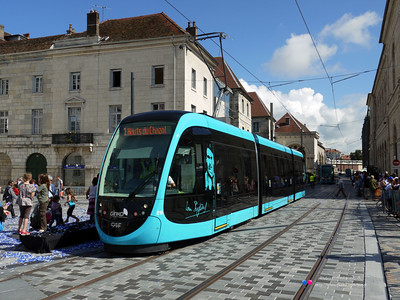=======
Note: Blogger has "upgraded" its interface and editing software, in ways that cripple the ability to write quickly. With the new interface, it takes 3x - 5x longer to "write" a piece if I want to include links and photos.
The editor also breaks up html code and does other weird things.
I'm thinking of switching to a new platform.
In the interim, I'm likely to write even less, even though there's plenty of topics and articles I'd like to tackle.
=======
I guess it's been awhile since I've been to Baltimore. Obviously, before the repainting of the Light Rail vehicles. Photo by Beyond DC from Flickr.The Baltimore Sun has an article, "Five years later, many across Baltimore bitterly lament Gov. Hogan’s decision to kill the Red Line light rail," about agita in Baltimore over Governor Hogan's cancellation of the proposed red line light rail program at the onset of his election.
It happens I wrote about Baltimore and transit in April, in advance of the Mayoral primary.
-- "Baltimore City Mayoral candidates views on transportation (and other matters)"
I wanted to come up with an ideal revitalization and economic development imbued transit agenda for Baltimore, based on my close analysis of transit in the Washington area--Washington DC proper and Arlington's Wilson Boulevard are national best practice examples of transit-based community revitalization, along the lines of other posts I've written such as:
-- "
Revisiting the Purple Line (series) and a more complete program of complementary improvements to the transit network" (2017, 2019
but the person I wanted to do it with is so despondent about Baltimore he couldn't get his head around it, and I didn't write anything.
The lessons of transit and economic development comparing DC and Baltimore. The basic lesson from comparing DC to Baltimore is that DC has a transit network, with six subway lines, complemented by a reasonable extensive bus system. By comparison, Baltimore has a single truncated subway line and a single light rail line that mostly follows the alignment of an old industrial railroad, meaning that it doesn't serve enough high demand activity centers and concentrated residential population.
As a result, being located by transit in Baltimore doesn't have nearly the same value as it does in the Washington Metropolitan Area. And the higher land values that result justify the extra costs of building mixed use projects and more densely developed areas.
Because transit in Baltimore doesn't have the same kind power that leads to concentrating on the center in DC and the inner suburbs, population and business activity continues to leak out of Baltimore.
Red Line proposal wasn't enough to change Baltimore's transit + economic development trajectory. The one thing about the Red Line proposal is that it was problematic, rooted in the fact that Baltimore doesn't have a transit network, it has a couple lines. It was designed to provide access to a major federal installation in Baltimore County, but the east-west alignment wasn't likely to make it convenient for workers to get there via transit.
In any case, the Red Line wasn't going to fix the problem of no network without additional and complementary measures.
It doesn't help that the recent "update" of Baltimore's area "transit" plan acknowledge the need to create a transit network in Greater Baltimore, with recommendations focused on addressing this omission*.
These are the five main points from the April piece:
1.
Re-make Baltimore's light rail and subway lines into an integrated network. It didn't get into specifics.
Just building the Red Line wouldn't have been enough. It would need to be complemented by:
1. Connecting the subway and light rail better in Downtown Baltimore.
2. Extending the subway to White Marsh.
3. Extending the light rail to Columbia on the south.
4. Rerouting the light rail to Towson, and extending it slightly on the north.
2. Expand the passenger railroad system, including multiple infill stations in Baltimore. (The 2002 area transportation plan called for 6 new stations in Baltimore, and 3 infill stations in Baltimore County.) Again, use the London Overground as the model.
And work with Virginia to merge the MARC Penn Line and the VRE Fredericksburg into a combined service, including it extending it on the north to connect with the SEPTA system in Wilmington, Delaware.
3. Integrate the fare media systems for passenger railroad service and local transit services.
4. Upgrade Baltimore's light rail transit vehicles. Transit in Baltimore needs a visual upgrade. Maryland should leverage the Purple Line project in Suburban Washington as a way to get the same type of design forward and new light rail cars for Baltimore.
These transit vehicles are produced by CAF, which is supposed to provide the train cars for the Purple Line.
5. Rebrand Baltimore Light Rail. Although given 1, 3, and 4, this goes without saying.
----------------------------------------------------------------------------------------
* Some items in the Regional Transit Plan for Central Maryland.
Mostly what is proposed are operational improvements, things like removing at-grade crossings, and the creation of transit hubs. The most significant recommended improvements for MARC are:
- working with Amtrak to improve the B&P Tunnel, which makes getting to Penn Station very slow
- rebuilding the West Baltimore Station
- the addition of a fourth track on the Penn Line between Odenton and Halethorpe
- creating a connection between the Camden and Penn Lines.
To be fair, the B&P Tunnel is a big deal, but Amtrak is the lead.
For light rail the plan's most significant recommendation is an infill station in the Texas area of Baltimore County, which at this time is minimally populated. It doesn't recommend a short extension northward to the Hunt Valley corporate business district (even though this was suggested to me by Greg Slater, then the planning director for the State Highway Administration and now the Secretary of MDOT). It doesn't recommend a southern extension to Columbia.
It doesn't address the subway in any significant way.


No comments:
Post a Comment